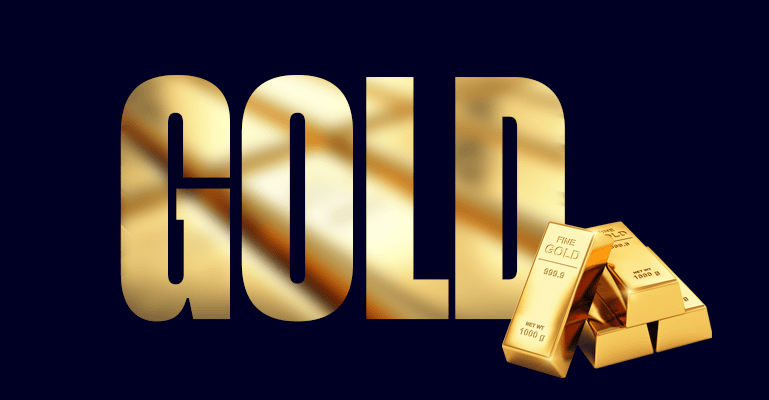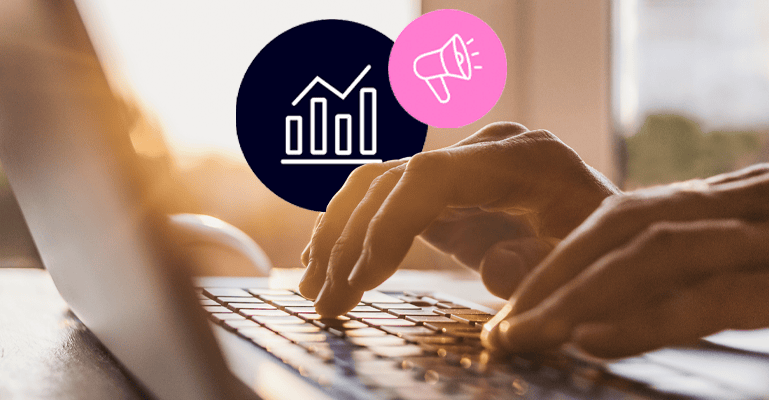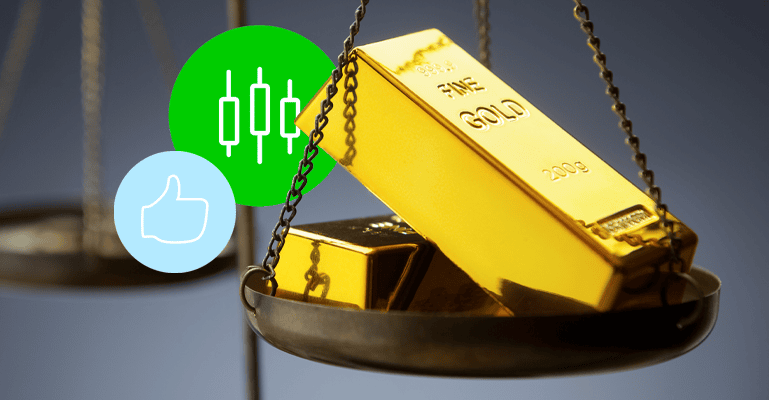The value of gold fluctuates minute by minute. Whether it’s held in physical form as a piece of jewellery or in a portfolio at a broker, the price keeps on changing, sometimes quite dramatically.
That creates opportunities for investors to make a profit by speculating outright on the metal’s next price move. Others buy gold as a ‘hedge’. The conventional thinking is that if your portfolio is weighted towards equities and the stock market tumbles, you might see your gold holding rise in value. One reminder that you can never take markets for granted comes from recent events where gold’s role as a contrarian asset was challenged. During the major market sell-off of March 2020 gold prices fell in line with other asset groups.
This article digs deeply into the role that gold plays, why you might want to improve your understanding of the asset’s many unique features and how you can gain exposure to it. When you feel ready to start investing in gold, the CFD markets offered here are an excellent place to start. You can trade gold and gold-related assets using live funds, or develop your trading skills using a Demo account.
Is gold a good investment?
Gold’s traditional role
Many investors hold gold due to its traditional role as a ‘hedge’ – an investment position that is expected to offset losses in other areas of a portfolio. That idea is based on the price of gold being inversely correlated to some other asset classes. As one goes down, the other goes up, and vice versa.
Currency risk
One asset group that gold is used as a hedge against is currencies, particularly the US dollar. As USD is the world’s reserve currency and is widely held, fears that it may fall in value can be offset by holding gold, which should go up in price if the greenback does weaken.
Inflation and gold
Additionally, gold can also be held as a hedge against inflation. Central bankers can (and do) sometimes print money to try and spend their way out of trouble. As the amount of gold available is finite, even if the money supply increases ten-fold, so should the price of gold.
Speculation
Gold’s role as a hedge and for managing risk has ironically led to it being traded for purely speculative reasons. Aware of all the hedging going on, another group of traders can use gold as a measure of how the forces of ‘greed and fear’ are playing out in the markets.
You don’t have to be looking to hedge risk to see gold as a good investment you just need to have an opinion on the direction the price is heading.
During the global financial crisis of 2007, the price of gold almost doubled in value in the space of only two years. This price spike was driven by fundamental investors putting on gold hedges but also by others spotting that trend and looking to buy early and benefit from the scramble to ‘safer’ assets.
Trading Gold
| ADVANTAGES | DISADVANTAGES |
| The ultimate hedge against a disaster or economic upheaval | US dollar currency risk |
| Protects your wealth | Not a passive investment |
| Diversifies your portfolio | Gold ETFs can carry higher fees |
| Inflation hedge | A paper gold investment still depends on the integrity of the financial system |
| Un-correlated to stocks and bonds | Over the long term, gold has historically sharply underperformed versus stocks and bonds |
| Holds its value over time | Gold appears to have no yield |
| Liquid investment despite the limited supply of gold |
The intrinsic value of gold over thousands of years and historical price data broadly point to gold prices being inversely correlated to other asset groups. However, the market meltdown of March 2020 led some to question the role of gold as a hedge. At one point, gold followed the rest of the market into freefall. That illustrates how the gold market remains an important feature of the financial ecosystem.
What impacts the price of gold?
A glance at the year to date price chart shows that gold prices have risen sharply. The usual suspects caused the 30% increase posted at the end of August 2020:
- A weakening US dollar – With 2020 an election year, the trade war with China has continued to rumble on
- Broader market uncertainty – The COVID-19 situation still has too many ‘unknowns’ in play
- US Presidential election – a classic example of an event that makes markets jittery and makes the safety of gold more attractive for investors
- Inflation is on the way – Central banks are pumping liquidity into the financial markets
- Unemployment – A politically sensitive issue that encourages government spending
The price move, as exemplified in the gold price chart above, reflects the fact that some investors are buying gold in line with its traditional role as a risk diversifier. The rapid rate of change and the price volatility is because others are spotting the trend and speculating on it. Both groups are applying the same reasoning, just for different purposes.
A quick scan of market news agencies reveals that a lot of commentators think that now might be the time to go long on gold.
-
- ‘Why Gold Is The Best Investment In The World Today’ (Forbes)
- ‘Gold rebounds over 2% on robust sentiment, dollar weakness’ (Reuters)
- ‘The currency of last resort’: Goldman says it’s time to buy gold as fear spreads across global markets’ (Business Insider)
- ‘Gold to Reach $3,000–50% Above Its Record, Bank of America Says’ (Bloomberg)
What are the different ways to trade gold?

There are three popular and well-established ways to invest in gold as an asset.
Can I trade gold using CFDs?
The most user-friendly and cheapest way is via investing in gold as a contract for difference, a CFD. A gold CFD is like trading stock on an exchange, except the instrument tracks the price of the underlying asset (in this case gold) but does not represent ownership of any of the precious metal.
Gold is one of the most popular assets within the class of precious metals, which includes palladium, silver and nickel. On the eToro platform, you can open a short position as well as a long position via this instrument. Once the order is completed, you can monitor the status of your trade-in the ‘Portfolio’ section.
Trading and holding positions in gold can be achieved in a variety of ways. Each process works in a slightly different way and, as a result, the fees associated with each are also different. This is something to consider and establishing which approach is most cost-effective for your strategy is possible using the information outlined in the T&Cs.
Add this instrument to your watch list here.
CFDs are complex instruments and come with a high risk of losing money rapidly due to leverage. 75% of retail investor accounts lose money when trading. CFDs with this provider. You should consider whether you understand how CFDs work and whether you can afford to take the high risk of losing your money.

What are gold ETFs?
A second approach would be by owning an exchange-traded fund (ETF). These offer a convenient way to hold a position in gold — no need to pay fees on a bank vault or take on the risk associated with having gold in physical form at home. ETFs such as SPDR Gold, and iShares Gold Trust also benefit from real-time pricing so you can easily keep on top of the value of your holding.

Trading gold-related equities
A third method would be to own a portfolio of equities that perform in line with the price of gold. For example, the gold deposits owned by gold mining companies may still be in the ground, but if the price of the metal moves so will the firm’s share price. The correlation between the price of gold stocks and gold itself can vary. Equities, after all, are also subject to other price drivers such as broader stock market volatility.
Each of the methods has its pros and cons. An interesting side note is that the most die-hard gold-bugs will stick with having at least some of their position held in physical form where they have physical access to it.
Their take on the situation has something of a doomsday feel to it. The thinking is that any scenario that sees gold being used as legal tender would be one so severe that your internet connection, broker’s offices or even bank vaults might no longer be secure.
How do I start trading gold?
Trading gold is an opportunity to diversify a portfolio, make a speculative profit or hedge against geopolitical risk. With the case made for considering entering the market, the next step is establishing how to buy gold.
Which are the best ways to dip a toe into gold trading?
Here at eToro, we make buying (or selling) gold as simple as clicking a button. Trading can be transacted using a desktop or hand-held device so that you can keep up with market events wherever you happen to be located.
How do you limit risk and ensure you don’t get carried away?
Market risk relates to the price of assets you hold going up or down, which generates profits or losses. Trading systems include features such as stop-loss orders which can help mitigate market risk. Another risk to be aware of relates to the security of the broker with which you place funds. Choose one that is regulated by tier-1 financial authorities, is trusted by millions of users and supported by known banks. An additional way to manage counterparty risk is to use insurance protection.
In what ways do inexperienced traders generally make mistakes?
Trading gold in CFD format also opens the door to using leverage, which is a means of scaling up your risk-return ratio. It is something for intermediate rather than beginner traders, as the price of gold can be quite volatile.
If you decide to trade with leverage set at x10, this means the position size will be 10 times the amount of cash you allocate to it.
So if you enter in a buy of $5,000 of gold and use x10 leverage, the actual position size (the ‘exposure’) will be $50,000. A 4% cash move on a position of $50,000 generates a return of +/- $2,000.
A $2,000 cash return on a $5,000 stake sounds terrific, but a $2,000 loss would seriously damage your trading objectives.

Leverage isn’t a complicated principle, but it is one you need to understand fully. You can find more information here. Also take comfort from the fact that here at eToro we allow clients to manage what, if any, leverage terms are used. The default is unleveraged trading.
Are there specific strategies that are best suited when you are learning about gold trading?
Finding a strategy that suits you is essential. Different strategies require more (or less) of your time and some work better in particular market conditions. While going on the very personal journey of finding a method that works for you, ensure that you trade in a small way.
When getting started with gold trading, you should consider the following factors:
- Familiarise yourself with the online broker you are executing through and its exposure to commodities, specifically gold, and what instruments you can trade.
- Establish the minimum tradable position. Gold and other commodities typically require larger cash balances than equities and forex.
- Gold can be high risk as an investment. It is vital to read a guide to trading gold before you embark on your first transaction. eToro has numerous education tools to support gold trading for all types of traders.
What are the more advanced strategies for trading gold?

Buy-and-hold
The historical reasons that make gold an attractive investment make some investors just want to buy a small amount of gold: a buy-and-hold asset. With this strategy, market timing is everything and patience might be required. Buying at a time when gold is near the lower end of it’s Bollinger Band range can result in you finding a better trade entry point.

More active trading strategies
Others use Technical or Fundamental analysis to predict a price move.
Technical analysis and charting strategies use historical price data and mathematical patterns to try and predict future price moves. Technical analysis is very data-driven, and there are a lot of advanced tools associated with it, all applying the information in slightly different ways. They include Fibonacci retracement, RSI (Relative Strength Index), MACD (Moving Average Convergence Divergence) and Ichimoku Clouds.
Fundamental analysis considers factors such as predicted mining reserves, central bank interest rate forecasts and political risk metrics.
A lot of strategies use a combination of technical and fundamental analysis but are different in terms of their holding periods. Day-trading and swing-trading strategies typically see traders holding positions for hours or days. Momentum-trading strategies might involve holding a position for weeks or longer.
How do I trade other precious metals?
Gold is not the only precious metal that can be utilised as a credible portfolio diversifier. Silver is its nearest cousin and trades roughly in line with gold, but it is not as pure a play due to silver being used more widely in industrial activity.
As silver is used to make things, a downturn in the economy can drag down the price of the metal more than it would gold.
Platinum is also considered an industrial metal, with significant demand coming from automotive catalytic converter manufacturers. As a result, platinum is particularly exposed to car sale volumes.
Lesser known is palladium, which has many electronic and industrial uses, including in solar energy, fuel cells and catalytic converters.
One group of metals increasingly catching the eye of investors is Rare Earth Metals (REM). These total 17 in number and include the 15 lanthanides, as well as scandium and yttrium. Their emergence as a tradeable asset stems from their use in industrial production, specifically batteries.
All precious metals offer unique inflationary protection, given that they have an intrinsic value and are limited in supply. However, it is gold that provides the strongest of safe-haven hedges to volatility and risk because it is far less affected by the laws of supply and demand.
How to trade gold with eToro
- Login or create an account by clicking here
- Head to our commodities markets page, select ‘gold’ to access the gold trading dashboard, then select ‘trade’
- Select BUY or SELL depending on the direction you wish to trade
- Enter the cash amount or number of units you want to trade
- Review and set the stop loss, leverage, and take profit parameters
- Select ‘open trade’

The life of a trade
Once you’ve opened a position in gold, it will show up in the ‘portfolio’ section. Post-trade management tools include a live profit and loss tracker showing the return on your trade.
Stop-loss or take profit tools can be added to your position at the time of trade execution or at any point afterwards. If either of these instructions is triggered by moves in the market price of gold, your position will be automatically closed out.
If you do not use stop-losses or take profit orders, you can still trade out of your position manually. In the portfolio section of your account, there are drop-down menus to direct you through the process of closing out your position when you feel that the time is right.
Final Thoughts
Trading gold using CFDs is relatively straightforward. If you use a well-regulated broker, then there is also the benefit of knowing it has a duty of care to its clients.

Millions of traders are now taking advantage of more convenient ways to trade gold. They don’t remove ‘market risk’ or the chance that you make the wrong call but it is possible to draw on quality research and learning materials. As with all trading, the better prepared you are, the more the odds are tilted in your favour. Choosing the right broker is part of that process.
Get started on eToro to learn more about Gold.
This information is for educational purposes only and should not be taken as investment advice, personal recommendation, or an offer of, or solicitation to, buy or sell any financial instruments.
This material has been prepared without regard to any particular investment objectives or financial situation and has not been prepared in accordance with the legal and regulatory requirements to promote independent research. Not all of the financial instruments and services referred to are offered by eToro and any references to past performance of a financial instrument, index, or a packaged investment product are not, and should not be taken as, a reliable indicator of future results.
eToro makes no representation and assumes no liability as to the accuracy or completeness of the content of this guide. Make sure you understand the risks involved in trading before committing any capital. Never risk more than you are prepared to lose.

